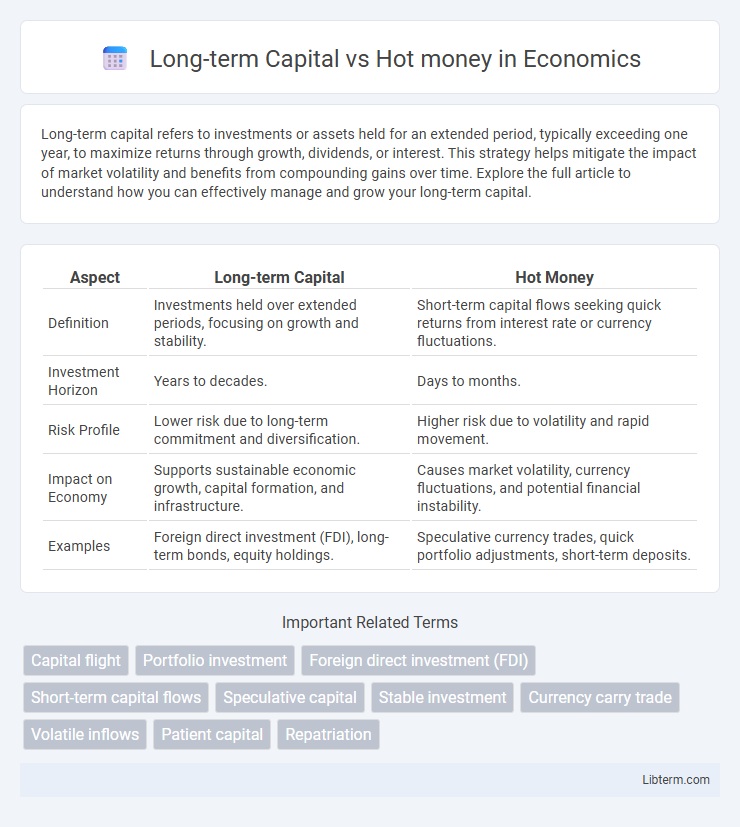Long-term capital refers to investments or assets held for an extended period, typically exceeding one year, to maximize returns through growth, dividends, or interest. This strategy helps mitigate the impact of market volatility and benefits from compounding gains over time. Explore the full article to understand how you can effectively manage and grow your long-term capital.
Table of Comparison
| Aspect | Long-term Capital | Hot Money |
|---|---|---|
| Definition | Investments held over extended periods, focusing on growth and stability. | Short-term capital flows seeking quick returns from interest rate or currency fluctuations. |
| Investment Horizon | Years to decades. | Days to months. |
| Risk Profile | Lower risk due to long-term commitment and diversification. | Higher risk due to volatility and rapid movement. |
| Impact on Economy | Supports sustainable economic growth, capital formation, and infrastructure. | Causes market volatility, currency fluctuations, and potential financial instability. |
| Examples | Foreign direct investment (FDI), long-term bonds, equity holdings. | Speculative currency trades, quick portfolio adjustments, short-term deposits. |
Understanding Long-term Capital: Definition and Characteristics
Long-term capital refers to investments held for extended periods, typically years, aimed at generating stable returns through assets like real estate, bonds, and equities. It is characterized by its commitment to growth, reduced sensitivity to short-term market fluctuations, and focus on fundamental value rather than rapid gains. This contrasts with hot money, which involves short-term capital flows driven by immediate profit opportunities and market speculation.
What is Hot Money? Key Traits and Behavior
Hot money refers to short-term capital that moves rapidly across borders seeking the highest short-term returns, often flowing into and out of emerging markets and financial instruments. Key traits of hot money include high volatility, sensitivity to interest rate changes, and a tendency to cause currency fluctuations and market instability due to its quick withdrawal during economic uncertainty. Its behavior contrasts with long-term capital, which is typically more stable, focused on sustained investment growth, and less reactive to immediate market shifts.
The Impact of Long-term Capital on Economic Growth
Long-term capital investments, characterized by stable and sustained funding in infrastructure, technology, and industry, significantly contribute to economic growth by enhancing productivity and promoting employment stability. Unlike hot money, which involves short-term speculative flows causing market volatility, long-term capital supports innovation and structural development critical for sustainable expansion. Empirical studies link increased long-term foreign direct investment to higher GDP growth rates, improved human capital development, and stronger institutional frameworks.
Risks and Volatility Associated with Hot Money
Hot money, characterized by rapid inflows and outflows in search of short-term gains, poses significant risks due to its high volatility and susceptibility to sudden market shifts. Unlike long-term capital, which tends to stabilize markets through sustained investment horizons, hot money can trigger abrupt currency fluctuations, destabilize exchange rates, and amplify financial crises. The unpredictability of hot money flows exacerbates economic vulnerability, particularly in emerging markets reliant on foreign capital for growth and liquidity.
Sources of Long-term Capital vs Hot Money Inflows
Long-term capital primarily originates from foreign direct investment (FDI), foreign institutional investors (FIIs), and sovereign wealth funds, emphasizing sustainable economic growth and stable returns through equity, bonds, and real estate. Hot money inflows consist of short-term portfolio investments, speculative currency trades, and rapidly moving capital from hedge funds or retail investors seeking quick gains driven by interest rate differentials or market sentiment. The stability and impact on financial markets differ significantly, with long-term capital providing steady funding while hot money can cause volatility and sudden capital flight.
Effects on Currency Stability and Exchange Rates
Long-term capital investments contribute to currency stability by promoting sustained economic growth and reducing volatility in exchange rates through steady inflows. Hot money, characterized by rapid short-term capital movements, often leads to exchange rate fluctuations and increased market volatility due to speculative trading and sudden withdrawals. Central banks may intervene to counteract the destabilizing effects of hot money, but long-term capital tends to foster a more resilient and predictable currency environment.
Policy Implications for Managing Capital Flows
Long-term capital investments provide stability and support sustainable economic growth, making them a priority for policymakers when designing capital flow management strategies. In contrast, hot money flows, characterized by rapid inflows and outflows, pose risks of financial volatility and currency destabilization, requiring the implementation of macroprudential measures such as capital controls and reserve requirements. Effective policy frameworks balance encouraging long-term capital inflows while mitigating the disruptive impact of speculative short-term capital movements to maintain economic resilience.
Case Studies: Countries Influenced by Hot Money
Countries like Thailand and South Korea experienced severe economic disruptions due to hot money inflows during the 1997 Asian Financial Crisis, where rapid withdrawal of speculative capital triggered currency collapses and financial instability. In contrast, long-term capital investment in countries such as Germany or Canada promotes sustained economic growth, infrastructure development, and improved financial resilience. Case studies emphasize that managing hot money flows through regulatory frameworks and capital controls is crucial for emerging markets to avoid volatility and maintain macroeconomic stability.
Strategies to Attract Sustainable Long-term Investment
Long-term capital attracts sustainable investment through stable economic policies, transparent governance, and robust legal frameworks that reduce risk and enhance investor confidence. Strategies include offering tax incentives, investing in infrastructure, and fostering innovation ecosystems to promote steady growth and value creation. Unlike hot money, which seeks quick profits, long-term capital prioritizes strategic partnerships and sectoral development for enduring economic benefits.
Balancing Short-term Gains with Long-term Economic Stability
Long-term capital investments contribute to sustainable economic growth by funding infrastructure, technology, and industry development, promoting stability in financial markets. Hot money flows, characterized by rapid movements seeking short-term gains, can cause volatility and disrupt economic planning. Balancing these capital types requires regulatory frameworks that encourage steady investment while mitigating risks from speculative, short-term capital influxes.
Long-term Capital Infographic

 libterm.com
libterm.com